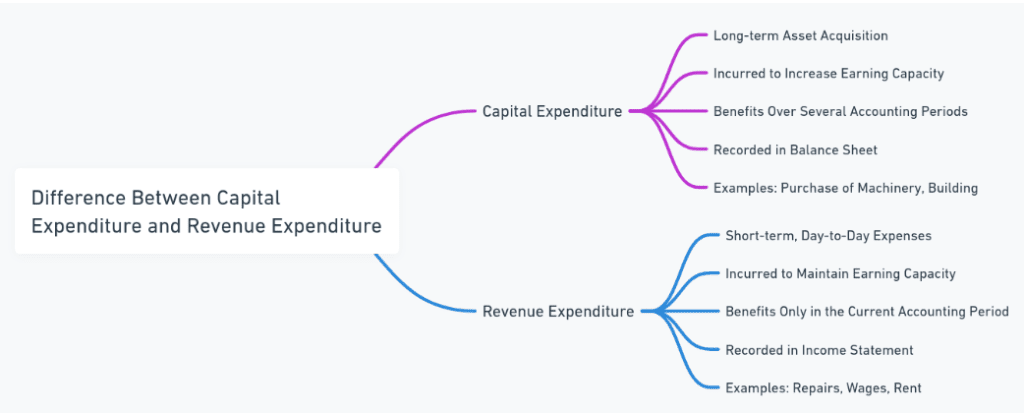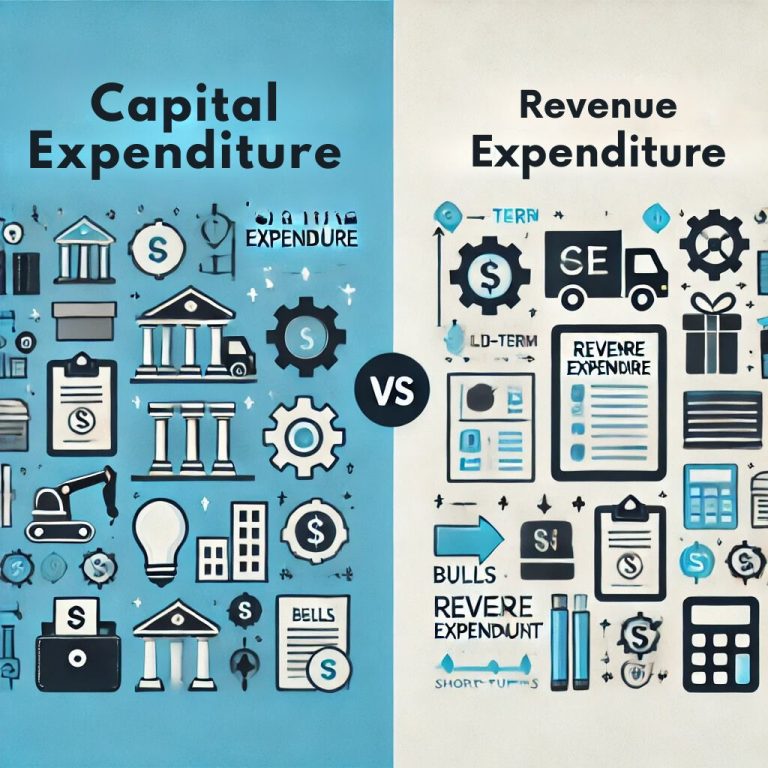Proper knowledge of the distinction between capital expenditure and revenue expenditure assists in determining appropriate accounting in accounting and finance. As explained above, both expenditures significantly facilitate the company’s financial decisions; however, they tend to fulfill two different purposes. Capital expenditures are expensed to acquire or improve long-lived assets that will generate future economic benefits, whereas revenue expenditures are incurred in the normal operations of the business; they are those expenses that maintain the ability of the company to continue its operation in the short term. These differences are helpful for proper financial reporting, making decisions, and tax treatments.

What is Capital Expenditure?
Capital Expenditure or CapEx is the spending that a company uses in acquiring, improving, and extending the life of long-term assets. Assets that are included in properties, equipment, or machinery help generate revenue over a long period. Capital expenditures occur only once and provide benefits exceeding the current accounting year.
Types of Capital Expenditure
There are several types of capital expenditures, each serving a distinct purpose in supporting a business’s long-term growth:
- Expansion CapEx: These are the funds used to expand the operational capacity of the company, which may include new facilities or new machinery acquisition.
- Upgrading CapEx: This is a type of expenditure that involves upgrading the efficiency or performance of existing assets. For example, the upgrade of software or machinery to increase productivity.
- Replacement CapEx: This refers to the costs incurred to replace old assets that have worn out or become obsolete, such as an old delivery truck or an outdated server system.
- New Asset Acquisition: The new assets are acquired to increase the scope of business operations; for example, obtaining new land for new offices.
Capital expenditures are typically listed on the balance sheet as assets, and their value is depreciated over time.
Did you know? The famous technology company Apple spent approximately $14 billion on capital expenditure in 2022, much of which went towards the development of its advanced data centers and retail stores worldwide.
What is Revenue Expenditure?
Revenue expenditure is the cost incurred in the daily running of a business. This contrasts with capital expenditure, which is beneficial in the long run. Revenue expenditure is to the advantage of a company in the short run. These are recurring expenditures incurred in the maintenance of the operations of the company within the accounting period.
Types of Revenue Expenditure
Revenue expenditures can be categorized into several types, each contributing to the routine functioning of the business:
- Operating Expenses: Operating Costs are the costs incurred by everyday business operations. These involve rent, utilities, and wages, etc.
- Repair and Maintenance: This is the cost the business incurs when repairs or maintenance of the assets so that they continue being used are necessary. For example, machinery to be repaired.
- Inventory Cost: This is the money spent on buying goods in order to sell them directly or raw materials to make their products.
- Administrative Expenses: These are the expenses of running the business and include office supplies and also administrative salaries, etc.
Revenue expenditure is recorded on the income statement and is subtracted from the company’s revenue to determine its net profit.
Capital vs Revenue Expenditure: Key Differences
In accounting, the difference between capital expenditure and revenue expenditure is essential for the preparation of correct financial statements and long-term decisions. Capital expenditure is usually defined as the purchase or acquisition of assets that will be used by the business over more than one year. These are costs incurred in the acquisition of machinery, building of infrastructure, and so on. Revenue expenditure, on the other hand, pertains to the costs that the business incurs while operating its business daily, such as paying salaries, rent, and utility bills. This spending is shown differently, and its impacts also differ on the income statement and the balance sheet.
| Criteria | Capital Expenditure | Revenue Expenditure |
|---|---|---|
| Definition | Expenditure for acquiring or improving long-term assets, which provides benefits for multiple accounting periods. | Expenditure incurred in the day-to-day operations of the business, which provides benefits only within the current accounting period. |
| Purpose | Incurred to increase the earning capacity of the business through new assets or upgrades. | A manufacturing company pays $10,000 per month in electricity bills for operating its machinery. |
| Duration of Benefit | Provides long-term benefits, usually more than one accounting year. | Provides immediate benefits, typically consumed within the same accounting year. |
| Example | Purchase of land, buildings, machinery, or vehicles; expansion of production facilities. | Salaries, rent, utility bills, repairs, and routine maintenance. |
| Financial Statement Impact | Recorded as an asset on the balance sheet and depreciated over time. | Recorded as an expense in the income statement, reducing net profit for the current year. |
| Depreciation | Depreciated over the useful life of the asset, spreading the cost across several years. | Not depreciated; fully expensed in the year it is incurred. |
| Frequency | Typically non-recurring or infrequent. | Recurring and frequent as part of daily operations. |
| Nature of Cost | High-value, one-time investments. | Low-value, ongoing operational costs. |
| Tax Treatment | Not fully deductible in the year incurred. Depreciation is used to spread the tax benefit over several years. | Fully deductible as an expense in the year it is incurred, reducing taxable income for the current year. |
| Balance Sheet Effect | Increases the value of assets on the balance sheet. | Does not affect the balance sheet; affects the income statement by reducing profits. |
| Effect on Profit | Has no direct impact on profit in the year incurred, except for depreciation. | Directly reduces profit as it is treated as an operating expense. |
| Examples in Practice | A manufacturing company purchasing new equipment for $500,000 that will be used for 10 years. | Office supplies, utility costs, staff wages, and insurance premiums. |
| Legal Perspective | Often requires special approval from management or shareholders due to its high value. | Typically within the operational discretion of managers without special approvals. |
| Cash Flow Impact | Involves large, one-time cash outflows, impacting long-term cash flow forecasts. | Involves regular, smaller cash outflows, affecting short-term cash flow management. |
| Reporting Period | Reported over several periods through depreciation. | Reported entirely in the current accounting period. |
| Resale Value | Assets acquired may have resale value or can generate future revenue. | Typically does not result in any resale value, as it is used to maintain operations. |
| Examples of Assets Purchased | Factories, land, office buildings, software licenses, patents. | Office supplies, utility costs, staff wages, insurance premiums. |
| Risk and Return | Represents a long-term investment with potential future returns. | Does not directly contribute to generating future revenue; maintains operational stability. |
| Associated with Business Growth | Drives growth by adding new assets or expanding existing capacity. | Necessary to sustain current business operations without contributing directly to growth. |
Importance of Correct Classification
Correct classification of capital and revenue expenditure is critical for several reasons:
- Accurate Profit Calculation: Misclassifying revenue expenditures as capital expenditures can overstate profits since capital expenditures are written off through depreciation rather than fully expensed in the year of purchase.
- Tax Implications: Capital expenditures often have different tax treatments compared to revenue expenditures. CapEx is subject to depreciation, while RevEx is fully deductible within the year incurred.
- Investment Decisions: Proper classification helps stakeholders and management make better decisions regarding the long-term financial health of the business.
Capital Expenditure & Revenue Expenditure FAQs
Is purchase of land a capital or revenue expenditure?
The purchase of land is a capital expenditure because it involves acquiring a long-term asset that will benefit the business for several years.
Are salaries classified as capital or revenue expenditure?
Salaries are considered revenue expenditure as they are regular payments made for the day-to-day functioning of the business.
How is capital expenditure accounted for?
Capital expenditure is recorded as an asset on the balance sheet and is depreciated over the asset’s useful life.
Can repair expenses be treated as capital expenditure?
Only if the repair extends the life of the asset significantly or improves its value. Otherwise, repairs are classified as revenue expenditure.
How does capital expenditure affect tax liability?
Capital expenditure is not immediately deductible from taxes but is depreciated over several years, providing a tax benefit across multiple accounting periods.


